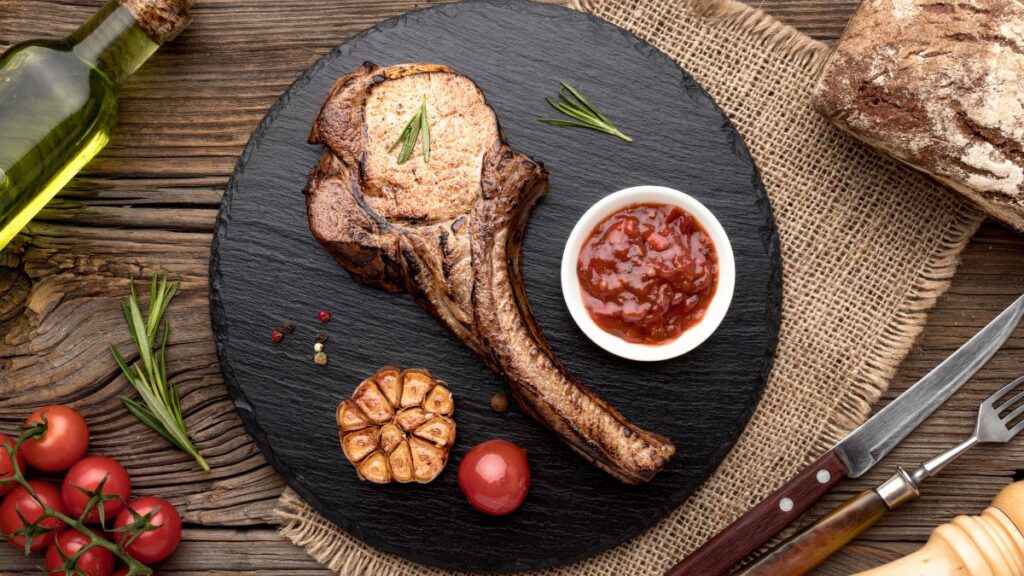When it comes to indulgent, show-stopping cuts of beef, few can match the cowboy steak. With its thick-cut, bone-in presentation, intense marbling, and robust flavor, this steak has become a favorite among meat lovers, steakhouse aficionados, and backyard grill masters alike.
In this comprehensive guide, we’ll explore everything there is to know about cowboy steak—what it is, its origins, how it compares to other steaks, the best cooking methods, how to shop for it, nutritional information, and even tips from chefs to make your experience unforgettable.
🥩 What Is a Cowboy Steak?
A cowboy steak is a bone-in ribeye that includes at least five inches of frenched bone, giving it a dramatic and rugged appearance. It’s essentially a bone-in ribeye, cut extra thick (usually about 2 to 2.5 inches) and often weighs between 18 to 32 ounces.
The exposed, cleaned bone is reminiscent of a handle—hence the “cowboy” moniker, evoking images of open-range cattlemen cooking steaks over an open fire.
🐄 Origins of the Cowboy Steak
While the exact origin of the term “cowboy steak” is hard to pinpoint, its imagery and cultural symbolism are tied deeply to the American West. Cowboys needed hearty meals after long days of herding cattle, and a thick ribeye steak, grilled over a campfire, would have been the perfect reward.
It’s a steak that celebrates beef in its most primal form—on the bone, thick-cut, marbled, and deeply flavorful.
🧠 Cowboy Steak vs. Tomahawk Steak: What’s the Difference?
People often confuse the cowboy steak with the tomahawk steak, and understandably so—they’re both ribeye cuts with a long bone. But there are a few distinctions:
| Feature | Cowboy Steak | Tomahawk Steak |
|---|---|---|
| Bone Length | About 2–5 inches | 8–12 inches (longer) |
| Bone Preparation | Frenched | Frenched |
| Weight | 18–32 ounces | 30–45 ounces |
| Appearance | Compact, thick | Elongated, dramatic |
| Cooking Ease | Easier to handle | Requires more space |
In essence, a tomahawk steak is an exaggerated cowboy steak, where the rib bone is left longer to mimic a tomahawk axe.
💎 Why Choose a Cowboy Steak?
If you’re a steak enthusiast, choosing a cowboy steak comes with several benefits:
-
Flavor: The bone and generous marbling provide depth and richness.
-
Juiciness: The thick cut retains moisture exceptionally well.
-
Presentation: It looks as bold as it tastes.
-
Versatility: Perfect for grilling, pan-searing, or sous vide.
Whether it’s a romantic dinner, a summer barbecue, or a special occasion, the steak is made to impress.
🛒 How to Choose the Perfect Cowboy Steak
When buying a cowboy steak, consider the following:
1. Grade of Beef
-
USDA Prime: Best quality, high marbling, most flavor.
-
USDA Choice: Good quality, slightly less marbling.
-
USDA Select: Leaner, less flavorful—better for budget-conscious buyers.
2. Marbling
The white flecks of fat within the muscle are key to flavor and tenderness. Look for even, fine marbling throughout the steak.
3. Thickness
Look for a steak that is at least 2 inches thick. This ensures you can sear it on the outside and cook to temperature without overcooking.
4. Bone Presentation
Ensure the bone is well-trimmed and frenched (scraped clean of meat for aesthetics and handling).
5. Source
High-end butchers or online purveyors like Snake River Farms, Allen Brothers, or Crowd Cow often offer premium cowboy steaks.
🔥 How to Cook a Cowboy Steak (4 Proven Methods)
Given its thickness and bone-in structure, the steak benefits from cooking techniques that allow both high heat and low, slow finishing.
1. Reverse Sear (Best for Grill or Oven)
This is the most foolproof method for evenly cooked steak.
Steps:
-
Preheat your oven or grill to 250°F.
-
Season steak generously with salt, pepper, and garlic powder.
-
Place steak on a wire rack over a baking sheet.
-
Cook until internal temp is about 110–115°F (rare) or 120°F (medium-rare).
-
Heat a cast-iron skillet or grill to high heat.
-
Sear each side for 1–2 minutes to develop a crust.
2. Sous Vide
This method allows for perfect precision.
Steps:
-
Vacuum seal or place the steak in a ziplock using water displacement.
-
Sous vide at 129°F for 2–4 hours (medium-rare).
-
Sear in a cast-iron skillet or over a hot grill for 1–2 minutes per side.
3. Grill (Direct + Indirect Heat)
The cowboy steak loves the grill—just be mindful of flare-ups due to fat content.
Steps:
-
Create two heat zones: one hot, one cooler.
-
Start the steak on the cool side with the lid closed.
-
Flip every 5 minutes until it reaches 110–115°F.
-
Move to hot zone for final sear.
4. Pan-Seared + Oven Finish
Ideal for home cooks with limited outdoor space.
Steps:
-
Preheat oven to 250°F.
-
Heat skillet to medium-high, add oil.
-
Sear each side for 2 minutes.
-
Transfer skillet to oven, cook until desired doneness.
🧂 Cowboy Steak Seasoning Tips
The best way to season a cowboy steak? Keep it simple:
-
Kosher Salt
-
Cracked Black Pepper
-
Garlic Powder
-
Smoked Paprika (optional for a smoky finish)
Let the meat rest with the seasoning for at least 45 minutes before cooking, or overnight in the fridge for a dry-brined effect.
🌡️ Internal Temperature Guide
| Doneness | Temp Before Resting | Final Temp After Rest |
|---|---|---|
| Rare | 120–125°F | 125–130°F |
| Medium Rare | 130–135°F | 135–140°F |
| Medium | 140–145°F | 145–150°F |
| Medium Well | 150–155°F | 155–160°F |
| Well Done | 160°F+ | 160°F+ |
Always use a meat thermometer for precision.
🧈 Recommended Cowboy Steak Toppings
Enhance your cowboy steak with complementary toppings:
-
Herb Butter (garlic, parsley, thyme, butter)
-
Mushroom Cream Sauce
-
Chimichurri
-
Blue Cheese Crumbles
-
Grilled Onions
🍷 Best Wines with Cowboy Steak
Pair your cowboy steak with robust, full-bodied wines:
-
Cabernet Sauvignon
-
Malbec
-
Syrah/Shiraz
-
Zinfandel
-
Bordeaux Blends
For a beer pairing, go with a porter, stout, or dark ale.
🥗 What to Serve with Cowboy Steak
Balance out the richness with sides like:
-
Garlic Mashed Potatoes
-
Grilled Asparagus
-
Roasted Brussels Sprouts
-
Corn on the Cob
-
Baked Sweet Potatoes
-
Caesar Salad
⚖️ Nutritional Profile of a Cowboy Steak
The nutrition of a cowboy steak can vary based on cut and preparation, but here’s an average profile for a 20 oz USDA Prime bone-in ribeye:
| Nutrient | Amount |
|---|---|
| Calories | ~1,200 kcal |
| Protein | 85–100g |
| Total Fat | 80–90g |
| Saturated Fat | 30–35g |
| Cholesterol | 250mg+ |
| Iron | 20% RDI |
| Vitamin B12 | 100% RDI |
Note: Cowboy steak is a protein powerhouse but should be enjoyed occasionally due to its high saturated fat and cholesterol content.
🛍️ Where to Buy Cowboy Steak Online
You can order high-quality cowboy steaks from reputable butchers and online platforms:
-
Snake River Farms (American Wagyu)
-
Crowd Cow (grass-fed options)
-
Porter Road (dry-aged beef)
-
Lobel’s of New York
-
Allen Brothers
Prices range from $30 to $90 per steak, depending on grade, origin, and size.
👨🍳 Pro Tips From Chefs
Here are insider tricks from professional chefs:
-
“Let it rest for at least 10–15 minutes after cooking. The juices will redistribute, and the steak will be more tender.” — Chef Raul Gonzalez, Miami
-
“Use compound butter with herbs and a touch of anchovy paste. It adds umami without overpowering the steak.” — Chef Amy Tran, LA
-
“Reverse sear is king. Start low and finish hot—it’s the secret to a perfect crust without overcooking.” — Chef Marcus LeBlanc, NYC
🤔 Frequently Asked Questions (FAQs)
Q: Is cowboy steak suitable for beginners?
A: Yes! Though thick, it’s forgiving due to its fat content. Use a thermometer and reverse sear method for best results.
Q: How long should I rest it after cooking?
A: Let it rest for at least 10–15 minutes, loosely tented with foil.
Q: Can I freeze cowboy steak?
A: Absolutely. Wrap tightly and freeze for up to 6 months. Thaw in the fridge 24–48 hours before cooking.
Q: Can I cook it from frozen?
A: Yes, but it’s harder to control doneness. Best to thaw for even cooking.
📌 Final Thoughts
The cowboy steak is not just a meal—it’s an experience. From its dramatic presentation to its juicy, beefy flavor, this cut is a celebration of everything steak should be. Whether you’re cooking it over a roaring grill or carefully reverse-searing it in your kitchen, a cowboy steak rewards your efforts with a dining experience that’s hard to beat.
If you’re ready to step up your steak game and try something bold, rich, and deeply satisfying, give the steak a try. With the right tools, ingredients, and technique, you’ll be enjoying one of the most iconic cuts of beef like a true steak connoisseur.






